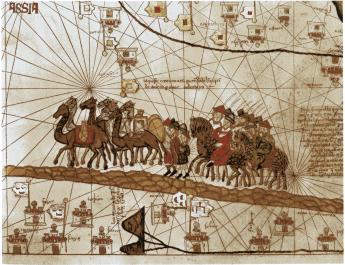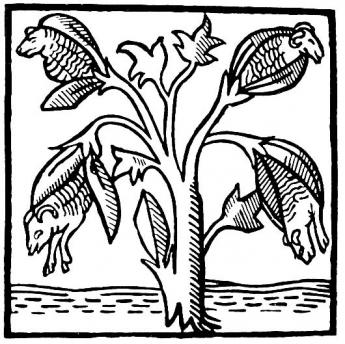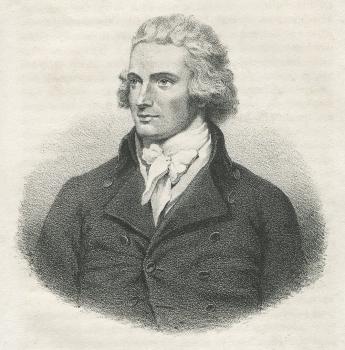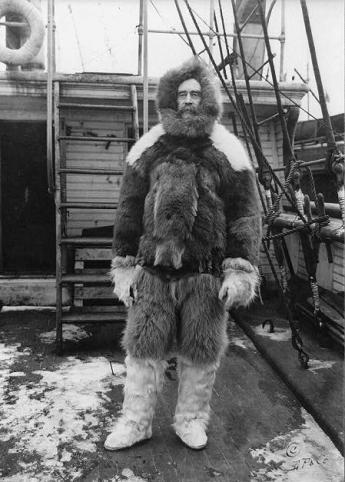Tip Verband Deutscher Antiquare e.V.
Tall Tales and Fictitious Voyages - Travel Books, Rare & Extraordinary

By Frank Werner
The literary hoax is as old as literature itself, as Melissa Katsoulis proves in her well-researched and amusing book “Telling Tales: A History of Literary Hoaxes”. Or just try entering “literary hoaxes” on Google.
Travel lies are as old as literature itself, or perhaps even older. Sailors, the quintessential travellers, are well known for their sailor’s yarns. And how better to impress the stay-at-homes than with stories of sea serpents, dwarfs, giants, headless or dog-faced people in faraway places? This was much more satisfying than telling of hard work, bad food and low pay.
The made-up travel tale in written or printed form can be divided into three genres:
Firstly the utopia, which is a literary form. It uses the medium of the travel tale to transport its moral contents. Thomas More’s “Utopia”, Cyrano de Bergerac’s voyage to the moon, Swift’s “Gulliver” or Holberg’s “Nils Klim” are typical. The aim of these books was not to deceive. Noone would take them at face value. They were read for what they were: alternative concepts of reality, descriptions of ideal forms of society, or, in Swift’s case, satire.
The adventure story is the second sub-genre. It ranges from the trivial to the sophisticated, as proved by Jules Verne, Daniel Defoe, or, in German, Karl May.
The travel yarns that want to be taken on face value are the most fascinating. They are written as factual accounts and are often hotly defended by the authors when doubted. Of course, there are many borderline cases, where fact and fiction are mixed, as for instance in Mandeville’s book “Le Liure appelle Mandeuille” 1480 (First English edition 1499: “Here begynneth a lytell treatyse or book named Johan Mandevyll, Knight … and speketh of the wayes of the Holy Londe towarde Jherusalem and of marveyles of Ynde and other diverse countrees”).
The exiting thing about the whole genre is the search for the untruth, proving the lie or the wild exaggeration. It is a wonderful offshoot of travel literature. The whole complex of “Travel Lies” would make a rich and satisfying collecting field for the lover of unusual and curious books.
Antiquity knew many travel tales, some literary as the Odyssey, some factual, as Pytheas of Massilia’s “Ultima Thule”. However, since no books or even fragments from that time exist, this need not occupy us here.
Marco Polo
One of the greatest and most famous travellers of all time is, of course, Marco Polo. What a story! A young merchant form Venice, in 13th century China. He is made a prefect by Kublai Khan himself, travels all over the vast empire for 17 years and returns home immensely wealthy: “Marco Millione”. His last words were: “I didn’t tell you half of what I saw.” Soon, however, doubts were cast upon his tale. He omitted everyday things like chop-sticks or tea, not a word about gunpowder or the Great Wall. In spite of these doubts the book was copied again and again, and the first printed edition appeared in German in 1477. (See the bibliography below for details.) Countless others followed, the book was translated into many languages. It is still a fascinating account, and has even inspired a Donald Duck story! Henze, in his seminal “Enzyklopädie der Entdecker und Erforscher”, proves on over 300 pages that it is nothing but a fabrication, the most colossal fraud in the history of exploration.
Jehan de Mandeville
About a hundred years after Polo, another traveller told his tale. Jehan de Mandeville is the name claimed by the compiler of a singular book of supposed travels, written in Anglo-Norman French, and published between 1357 and 1371. “Le Liure appelle Mandeuille” was translated into many languages and acquired an extraordinary popularity. There are 200 manuscripts in 10 languages. Despite the extremely unreliable and often fantastical nature of the travels it describes, it was used as a work of reference – Christopher Columbus, for example, was heavily influenced by both this work and Marco Polo’s. It is possible that the unknown author visited Constantinople, Palestine and Egypt. However, he claims to have seen China, India, and Tartary, to have drunk at the Fountain of Youth, have been through a haunted valley, and have finally been driven home by gout. The book was first printed in Lyon in 1480. It became an instant bestseller, soon decorated with wonderful crude woodcuts, and reprinted again and again.
Gutenberg made his invention around 1450. The printing press changed the world and rightly earned him the title “Man of the Millenium”. About fifty years later, Columbus discovered the New World. The earth was being unveiled, and the reports and tales of the discoverers were printed and distributed promptly. As more and more people became literate, the interest in adventure stories, discoveries and news of far-off lands grew. At the same time, navigation aids and ships themselves improved – the age of discovery was here.
Ferdinand Mendez Pinto
One who travelled further than most was Ferdinand Mendez Pinto. He was a Portuguese explorer and writer. His exploits are known through the posthumous publication of his memoir “Peregrinacao” in 1614, an autobiographical work whose validity is nearly impossible to assess. In the course of his travels in the Middle and Far East, Pinto visited Ethiopia, the Arabian Sea, China (where claimed to have been a forced labourer on the Great Wall), India and Japan. He claimed to have been among the first group of Europeans to visit Japan. He also claimed to have introduced the gun there in 1543. The vivid tales of his wanderings over twenty years – he wrote, for example, that he was “thirteen times made captive and seventeen times sold” – were so unusual that they were mostly not believed. By 1700, his wonderful book had gone through nineteen editions, and had been translated into six languages.
America had been discovered and was seen to hold vast wealth, especially in gold. The Conquistadores shipped huge amounts of this precious metal back to Spain, where it was badly needed for the wars that Spain was constantly waging. The treasure ships were the dream of all pirates and privateers sailing the Spanish main. England (protestant) and Spain (catholic) were at each other’s throats nearly all the time, even in times of peace. England wanted it’s part of the New World and began to establish colonies there.
Cities of Gold
Onto this stage strode the quintessential Elizabethan: aristocrat, writer, poet, soldier, courtier (and rumoured lover of the Virgin Queen), spy and explorer: Sir Walter Raleigh. He was involved in the early English colonization of Virginia under a royal patent. In 1594 Raleigh heard of a “City of Gold” in South America and sailed to find it. On this voyage he claimed to have met the famous Amazons, the female warrior tribe. He mixed own observations freely with exaggerations and rumours. All this he published in his “Discoverie of the Large, Rich and Bewtifull Empire of Guiana …” in 1596. Orellana later called the river that he had sailed up the Amazon, after that tribe which Raleigh claimed to have seen there.
The 18th century was the century of enlightenment. Mungo Park reached the Niger, Cook proved that Terra Australis did not exist, Gmelin, Steller and others studied Siberia. And of course, the tall tale tellers flourished.
George Psalmanazar
A colourful figure of this turbulent century was George Psalmanazar. He claimed to be the first native of Formosa to visit Europe. He arrived in London, more or less from nowhere, under the tutelage of a Scottish priest, who claimed to have converted and christened him. This exotic foreigner was soon all the rage in London. He explained his light complexion with having lived underground. He ate raw meat and used a strange calendar. And he fed the anti-catholic feelings of the day by claiming to have been abducted from his native isle by malevolent Jesuits. In 1704 Psalmanazar published a book entitled “An Historical and Geographical Description of Formosa … “ He even made up a Formosan language and alphabet, which is shown on one of the plates. The “facts” contained in the book were in fact an amalgam of other travel reports, and were especially influenced by accounts of the Aztec and Inca civilisations in the New World and by embellished descriptions of Japan. The book was a great success. It went through two English editions, and German and French translations followed. However, the story was soon doubted. In 1706 he confessed the fraud. Later he became a poor but respected theological essayist and a friend of Samuel Johnson and other noted figures of 18th century literary London. In the last years of his life, he wrote the book upon which much of our knowledge of him rests: “Memoirs of ***, Commonly Known by the Name of George Psalmanazar; a Reputed Native of Formosa”. The book was published posthumously. Sadly, he omitted to give his real name.
Magister Junge
Even today, the three writers Taurinus, Schrödter and Damberger are often taken on face value. Zacharias Taurinus published a book called “Beschreibung einiger See- und Landreisen nach Asien, Afrika und Amerika…” (Description of divers sea- and land voyages to Asia, Africa and America” in 1799. An artisan from Saxonia, Schrödter, wrote „See- und Landreisen nach Ostasien und Ägypten“ (Sea- and land voyages to East india and Egypt.“ And Friedrich Damberger, finally, published „Landreise in das Innere von Afrika vom Vorgebirge der guten Hoffnung bis nach Marocco …“ This was translated into English as „Travels in the Interior of Africa, From the Cape of Good Hope to Morocco …“ These tales were suspicious even to their contemporaries. The puzzle was finally resolved, when it was discovered that a certain Magister Junge had written all three books. He was working in Wittenberg at that time, as an antiquarian bookseller.
Mungo Park killed by natives
Mungo Park’s second voyage gave rise to a hoax perpetrated by a German publisher who would not wait for official news of this traveller. When nothing had been heard from Park for some time, he commissioned an unknown author to make up his own version of his (Park’s) demise and published it. This book is still often cited as a “true” account, even though in it Park is robbed and killed by natives in a stony desert – just about the very opposite to what actually happened to him.
The 19th century was the century of the scientific traveller and explorer. Cook had made the start by mapping the Pacific, Hedin set foot in Asia for the first time, the poles were being attempted. And then there was Africa, dark, mysterious and just waiting to be colonized and exploited. As always the hoaxers were there first. In 1832 a certain Douville published “Voyages au Congo et dans l’interieur de l’Afrique” in 3 volumes with an atlas. Most of the book was pure fantasy, with a few excerpts from older or unpublished writers thrown in.
And then there was Gilarmi Antonio Farini “The Great Farini”, real name William Leonhard Hunt. He was a well-known Canadian tightrope walker, entertainment promoter and inventor, and supposedly the first white man to cross the Kalahari on foot. Before this feat, he crossed the Niagara Falls several times on a tight-rope, once stopping halfway to fry an egg. He left 1885 for Africa and made his famous crossing of the Kalahari, even claiming to have found the Lost City of the Kalahari. None of his claims have ever been verified, in fact H. Schinz has proved conclusively that they were a fabrication.
One would think that the scope for frauds would be much reduced by modern inventions like photography, the aeroplane or the car. Better instruments made for better observations. A picture could tell more than a hundred words. But no: The good old travel lies flourished.
North Pole?
Admiral Byrd for instance, of Antarctic fame, claimed to have flown over the North Pole in 1926. As his co-pilot Floyd Bennett said later: “Byrd and I never got to the pole.” Others were also striving to attain the North Pole.
At the beginning of the 20th century two Americans hotly contested the honour of being first: Robert E. Peary and Frederick Cook. Peary invented the method, named after him, of adopting Eskimo dress and modes of travel. He made several winterings on Greenland, from where he brought back not only furs and ivory, but a large iron meteorite that he had stolen from the Inuits and thus depriving them of their only source of metal. He also brought back several Inuit men who were kept in the basement of the Smithsonian institution as anthropological specimens and soon died. And he had several children with Inuit women. “(He was) undoubtedly the most driven, possibly the most successful and probably the most unpleasant man in the annals of polar exploration”, says F. Fleming in his “Ninety Degrees North”. In 1909 he made his final assault on the pole. On the final stage of the journey he was accompanied only by four Eskimo and his black servant, Henson. Surprisingly, the distances he covered after he had sent back his European companion, increased hugely and on April 7th he reached the pole. Strangely, the pages of his dairy for that momentous day are torn out, and loose leaves are inserted. On his return he learned to his dismay that someone had stolen his thunder.
Frederick A. Cook was an American physician who had accompanied both Peary’s arctic expedition and de Gerlache’s “Belgica” expedition to the Antarctic. He also claimed to have climbed Mt. McKinley. This claim was soon debunked. In 1908 he made an attempt on the North Pole. Accompanied by two Inuit men he set off into the ice and was not heard of again for fourteen months. He then re-appeared and claimed to have reached the pole. However, in view of the amount of provisions he had with him, and his and his companions conflicting accounts, this was highly unlikely. What he apparently describes is his attainment of Jules Verne’s “Pole du Froid”, which was much easier to reach. Cook was later convicted for fraud and spent most of the rest of his life in jail.
As soon as Cook and Peary returned to America, battle was joined. Both had their supporters, and both had opponents. Cook’s claim was soon dismissed, and Peary’s account was doubted. Both men wrote books, supporting their claim. The first man to have walked to the pole and could prove it was the great arctic explorer Wally Herbert, in 1969.
With this short history of tall tales, I have only scratched the surface. There are many more tales of mystery and imagination waiting to be found. I hope I have been able to whet the appetite a little!
Bibliography
As I said before, an enthralling and amusing field of collecting. However, to be able to do any useful research, the collector should have a few reference books. Here are some that I used in the research for this essay:
Adams, Peary G. Travellers and Travel Liars 1660-1800.
Howgego, Raymond John. Encyclopedia of Exploration. Hordern House 2003-2008. In the best tradition of the genre, this magnificent work has a spoof entry!
Henze, Dietmar. Enzyklopädie der Entdecker und Erforscher der Erde. Akademische Druck- und Verlagsanstalt 1978-2004.
Pleticha, Heinrich. Die Fahrt nach Nirgendwo. Erdmann 2003.
Of course, the internet is a great, but sometimes unreliable, help. Here are some bibliographical notes on the books mentioned in the order that they appear in the text:
Polo, Marco. Hie hebt sich an das puch des edeln Ritters vn landtfarers / Marcho polo. In dem er schreibt die grossen wunderlichen / ding dieser welt. Nürnberg, Creuszner, 1477. with a portrait frontispiece. 58 unnumbered leaves. First English edition: The most noble and famous trauels of Marcus Paulus … into the east partes of the world … London 1579.
Mandeville or Maundeville, John. Le Liure appelle Mandeuille. [Lyon] 1480. 88 leaves. First edition, printed in February, the second edition followed in April of the same year. The printer is unknown. First English edition: Here begynneth a lytell treatyse or book named Johan Mandevyll, Knight … and speketh of the wayes of the Holy Londe towarde Jherusalem and of marveyles of Ynde and other diverse countrees. Westminster, de Worde, 1499.
Pinto, Fernao Mendes. Peregrinacao … em que da conta de muytas y muyto estranhas cousas … Lisboa Pedro Craesbeeck, 1614. 303 leaves. First English edition: The Voyages and Adventures of Fernand Mendez Pinto … During his Travels for the space of one and twenty years in The Kingdom of Ethiopia, China, Tartaria, Cauchin – china, Calaminham, Siam, Pegu, Japan, and a great part of the East-Indies. London, Macock for Cripps, 1653. 326 pp.
Raleigh, Walter. Discoverie of the Large, Rich and Bewtifull Empire of Guiana, with Relagion of the Grand Golden City of Manoa … London, Robinson, 1596. 112 pages.
Psalmanazar, George. An Historical and Geographical Description of Formosa. An Island subject to the Emperor of Japan. London, Brown, 1704. 131 pages and 15 plates.
Damberger, Christian Friedrich. Landreise in das Innere von Afrika vom Vorgebirge der Guten Hoffnung … bis nach Marocco … Leipzig, Martini, 1802. 2 volumes. With 2 plates and a map. First English edition: Travels in the interior of Africa: from the Cape of Good Hope to Morocco. London 1801.
Schrödter, Josef. See- und Landreisen nach Ostindien und Ägypten. Leipzig 1800. No English translation.
Taurinus, Zacharias. Beschreibung einiger See- und Landreisen nach Asien, Afrika u. Amerika … Leipzig, Jacobäer, 1799-1801. 1022 pages. No English translation.
Mungo Parks neueste und Letzte Reise ins Innere von Afrika nebst dem Tode dieses merkwürdigen Reisenden aus seinem Tagebuche … herausgegeben … Hamburg, Müler, 1807. 384 pages. No English translation.
Douville, Jean-Baptiste. Voyage au Congo et dans l’interieur de l’Afrique Equinoxiale. Paris, Renouard, 1832. 3 volume and an atlas with 20 plates and a map. No English translation.
Farini, Gilarmi Antonio (= William Leonhard Hunt). Through the Kalahari Desert. Narrative of a journey with gun, camera, and note-book to Lake N’Gami and back. New York, Scribner and Welford, 1886.475 pages. Well illustrated.
Byrd, Richard E. Skyward. New York and London, Putnam 1928. Well illustrated. There is a limited edition of 500 copies, signed by the author and with a piece of the fabric which covered his plane mounted to the front pastedown.
Peary, Robert E. The North Pole. The discovery in 1909 under the auspices of the Peary Arctic Club. New York, Stokes, 1910. 373 pages. Well illustrated.
Cook, Frederick. My Attainment of the Pole … With the final summary of the Polar Controversy. New York, The Polar Publishing Co., 1911. 604 pages. Illustrated.
Frank Werner of Brockhaus/Antiquarium (Kornwestheim, Germany) is specialized in travel and exploration. The article is published here by permission of the author. Thanks very much.



